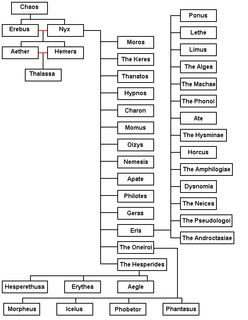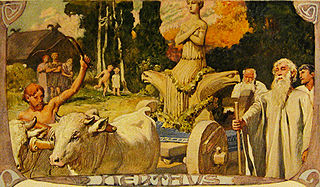Related Research Articles

Joseph John Campbell was an American professor of literature at Sarah Lawrence College who worked in comparative mythology and comparative religion. His work covers many aspects of the human experience. Campbell's best-known work is his book The Hero with a Thousand Faces (1949), in which he discusses his theory of the journey of the archetypal hero shared by world mythologies, termed the monomyth.

A nymph in ancient Greek folklore is a minor female nature deity. Different from Greek goddesses, nymphs are generally regarded as personifications of nature, are typically tied to a specific place or landform, and are usually depicted as beautiful maidens. They were not necessarily immortal, but lived much longer than humans before they died.

In Greek mythology, Erebus, also Erebos, was often conceived as a primordial deity, representing the personification of darkness; for instance, Hesiod's Theogony identifies him as one of the first five beings in existence, born of Chaos.
In Norse mythology, Árvakr and Alsviðr are the horses which pull the sun, or Sól's chariot, across the sky each day. It is said that the gods fixed bellows underneath the two horses' shoulders to help cool them off as they rode.
In Norse mythology, Jörmungandr, also known as the Midgard (World) Serpent, is a sea serpent, the middle child of the giantess Angrboða and Loki. According to the Prose Edda, Odin took Loki's three children by Angrboða—the wolf Fenrir, Hel, and Jörmungandr—and tossed Jörmungandr into the great ocean that encircles Midgard. The serpent grew so large that it was able to surround the Earth and grasp its own tail. As a result, it received the name of the Leviathan or World Serpent. When it releases its tail, Ragnarök will begin. Jörmungandr's arch-enemy is the thunder-god, Thor. It is an example of an ouroboros.

Indra is an ancient Vedic deity in Hinduism. He is a guardian deity in Buddhism, and the king of the highest heaven called Saudharmakalpa in Jainism. He is also an important deity worshipped in Kalasha religion, indicating his prominence in ancient Hinduism. Indra's mythology and powers are similar to other Indo-European deities such as Jupiter, Perun, Perkūnas, Zalmoxis, Taranis, Zeus, and Thor, suggesting a common orgin in Proto-Indo-European mythology.

Hindu mythology are narratives found in Hindu texts such as the Vedic literature, epics like Mahabharata and Ramayana, the Puranas, the regional literatures like Periya Puranam. Hindu mythology is also found in widely translated popular texts such as the Panchatantra and Hitopadesha, as well as Southeast Asian texts.

The indigenous peoples of the Americas comprise numerous different cultures. Each has its own mythologies. Some are quite distinct, but certain themes are shared across the cultural boundaries.

Germanic mythology consists of the body of myths native to the Germanic peoples. The category includes Norse mythology, Anglo-Saxon mythology, and Continental Germanic mythology. It was a key element of Germanic paganism. These stories establish the creation and creature myths that permeated Northern European cultures. They are concerned with the deities, mythical creatures, places and customs that shaped the early and proceeding Germanic peoples.
Baltic mythology is the body of mythology of the Baltic people stemming from Baltic paganism and continuing after Christianization and into Baltic folklore. Baltic mythology ultimately stems from Proto-Indo-European mythology. The Baltic region was one of the last regions of Europe to be Christianized, a process that occurred from the 15th century and into at least a century after. While no native texts survive detailing the mythology of the Baltic peoples during the pagan period, knowledge of the mythology may be gained from Russian and German chronicles, later folklore, by way of etymology, and comparative mythology.

The traditional African religions or traditional beliefs and practices of African people are a set of highly diverse beliefs that includes various ethnic religions. Generally, these traditions are oral rather than scriptural and passed down from one generation to another through folk tales, songs and festivals, include belief in an amount of higher and lower gods, sometimes including a supreme creator or force, belief in spirits, veneration of the dead, use of magic and traditional African medicine. Most religions can be described as animistic with various polytheistic and pantheistic aspects. The role of humanity is generally seen as one of harmonizing nature with the supernatural. According to the author Lugira, "it is the only religion that can claim to have originated in Africa. Other religions found in Africa have their origins in other parts of the world."

Greek mythology is the body of myths originally told by the ancient Greeks and a genre of Ancient Greek folklore. These stories concern the origin and the nature of the world, the lives and activities of deities, heroes, and mythological creatures, and the origins and significance of the ancient Greeks' own cult and ritual practices. Modern scholars study the myths in an attempt to shed light on the religious and political institutions of ancient Greece and its civilization and to gain understanding of the nature of myth-making itself.

Norse mythology is the body of myths of the North Germanic peoples, stemming from Norse paganism and continuing after the Christianization of Scandinavia, and into the Scandinavian folklore of the modern period. The northernmost extension of Germanic mythology, Norse mythology consists of tales of various deities, beings, and heroes derived from numerous sources from both before and after the pagan period, including medieval manuscripts, archaeological representations, and folk tradition.
Myth is a folklore genre consisting of narratives that play a fundamental role in a society, such as foundational tales or origin myths. The main characters in myths are usually gods, demigods, or supernatural humans. Stories of everyday human beings, although often of leaders of some type, are usually contained in legends, as opposed to myths.
The concept of an otherworld in historical Indo-European religion is reconstructed in comparative mythology. Its name is a calque of orbis alius, a term used by Lucan in his description of the Celtic Otherworld.

Celtic mythology is the mythology of Celtic polytheism, the religion of the Iron Age Celts. Like other Iron Age Europeans, the early Celts maintained a polytheistic mythology and religious structure. For Celts in close contact with Ancient Rome, such as the Gauls and Celtiberians, their mythology did not survive the Roman Empire, their subsequent conversion to Christianity and the loss of their Celtic languages. It is mostly through contemporary Roman and Christian sources that their mythology has been preserved. The Celtic peoples who maintained either political or linguistic identities left vestigial remnants of their ancestral mythologies that were put into written form during the Middle Ages.
Paleo-Balkan mythology is the group of religious beliefs held by Paleo-Balkan-speaking peoples in ancient times, including Illyrian, Thracian and Dacian mythologies.
References
- ↑ Forty, Jo, Mythology: A Visual Encyclopedia. PRC Publishing Ltd. 1999, ISBN 1902616537, Chapter 7 "Oceania", page 508
- ↑ Beckwith, Martha Warren (1940). Hawaiian mythology. Yale University Press (republished by Forgotten Books). pp. 267–268. ISBN 978-1-60506-957-9.
| This article relating to a myth or legend from Oceania is a stub. You can help Wikipedia by expanding it. |